AMD’s Radeon HD 6670 & Radeon HD 6570: Two’s Company, Sub-$100’s A Crowd
by Ryan Smith on April 19, 2011 12:01 AM ESTPower, Temperature, and Noise
Last but not least as always is our look at the power consumption, temperatures, and acoustics of the Radeon HD 6670 and Radeon HD 6570. As we’ve noted previously, these reference designs won’t be sold in the retail market, so while our performance data and power data should be consistent with other cards, temperature and noise data is going to be very dependent on the specific cooler used.
| Radeon HD 6570/6670 Voltage | |||||
| 6570 Idle | 6670 Idle | 6570 Load | 6670 Load | ||
| 0.9v | 0.9v | 1.1v | 1.1v | ||
Both the 6670 and 6570 have the same load voltage of 1.1v. This caught us a bit off guard, since lower clocked parts normally enjoy a lower load voltage. This will be of importance when we’re looking at load power consumption.
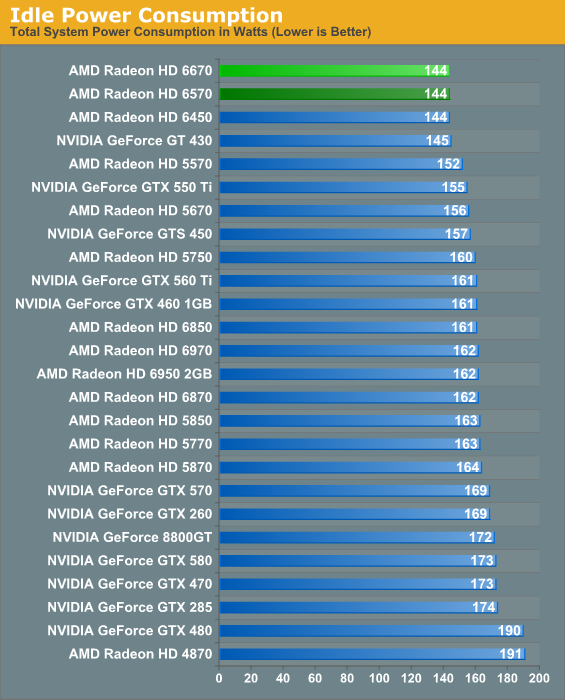
At idle we’re running up against the limits of what a 1200W PSU can do. In reality the 6450 should be consuming at least a few watts less than the 6670 and 6570. The fact that all 3 cards are among the lowest power consuming cards at idle is not a mistake, however.
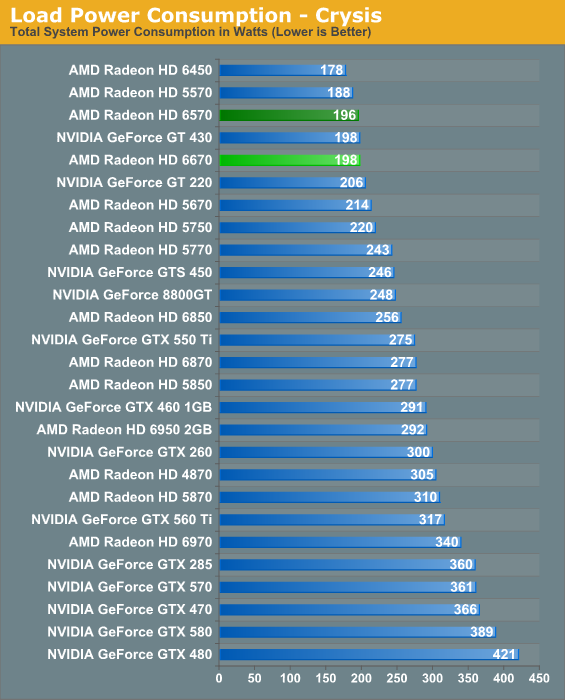
Our Crysis power data surprised us some, and we’re still trying to get to the whys. Both the 6670 and 6570 ended up being sub-200W; this is notable because the 5670 draws 214W in the same test and has a slightly lower TDP than the 6670. In spite of what the specs say, for whatever reason the 6670 is clearly well ahead of the 5670 in both power consumption and performance when it comes to Crysis.
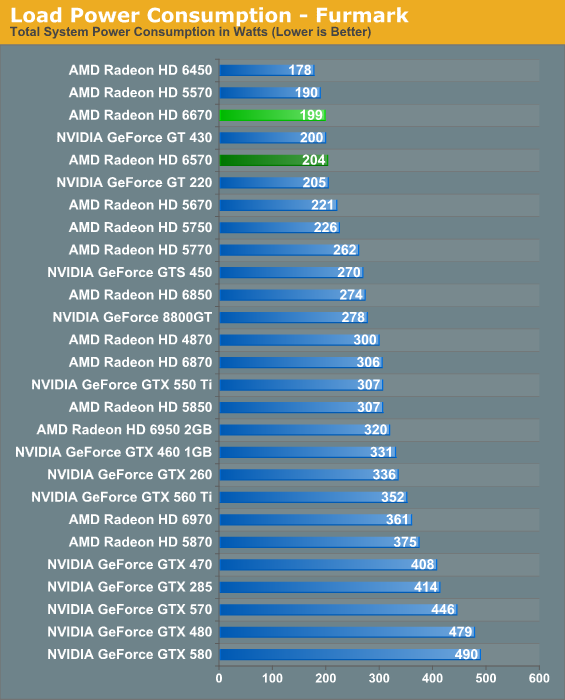
FurMark confirms what we’ve seen with Crysis: the 6670 and 6570 consume less power than the 5670 even with their similar TDPs. In fact the 6570 consumes 5W more than the 6670 even though the latter is the higher clocked and should be the higher consuming card. Given that both cards use fully enabled GPUs at the same load voltage, the difference looks to come down to minor variations in the quality of the individual chips. In this case our 6670 appears to use a better chip than our 6570, hence the difference.
In any case the load power consumption looks very good. The 6670 edges out even the much slower GT 430, while the 6570 similarly edges out the GT 220 DDR3. AMD has done a lot of work on power consumption for Northern Islands and it shows. Meanwhile the fact that the 5750 draws around 25W more is both a curse and a blessing – 25W is quite a lot when Turks cards only draw around 60W in the first place, on the other hand that 25W comes with a lot more performance.
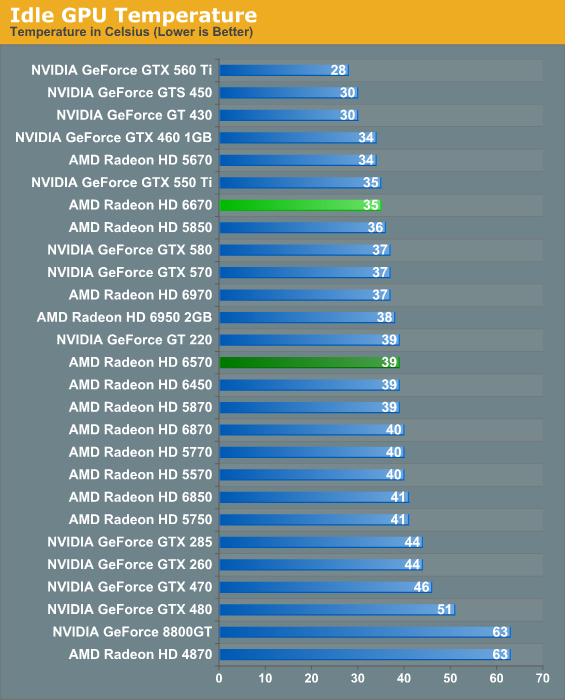
Idle temperatures are roughly where we expect them to be. The 6570 is consistent with the other cards using that model cooler, while the 6670’s new double-wide cooler makes it competitive with all but the coolest of our cards.
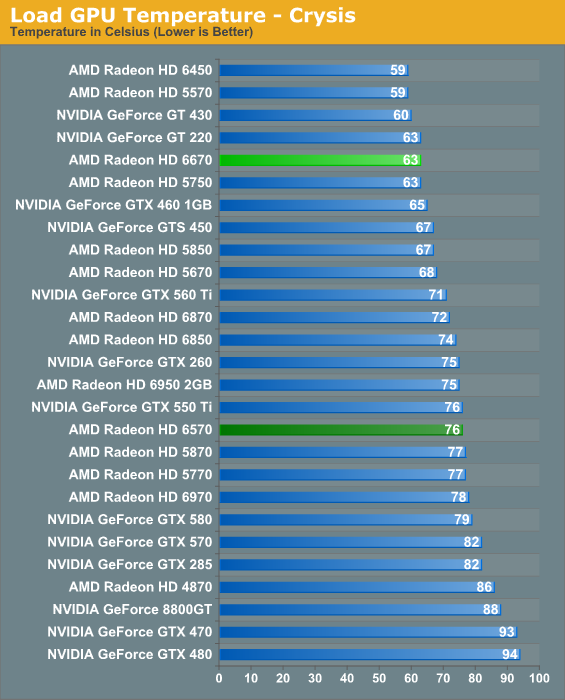
Since we’ve already established that the 6670 and 6570 have similar levels of power consumption, temperatures are almost entirely a product of the cooler in use. The 6670 has a larger cooler that can move more air, and as a result it’s much cooler than the 6570 under Crysis. In fact the 6570 is probably at its limits for what AMD’s single-wide low-profile cooler can do; dissipating the roughly 40W the GPU produces is no small task for such a small cooler.

Coming from Crysis our temperatures rise slightly, as is normally the case. At 69C the 6670 is extremely well cooled, while the 6570 is quite warm at 82C. Though we won’t see either cooler at retail, this should be a good idea of the range we should expect to see. A double-wide cooler should make for a very cool card, while a single-wide cooler delivers reasonable performance but it will definitely be warm.
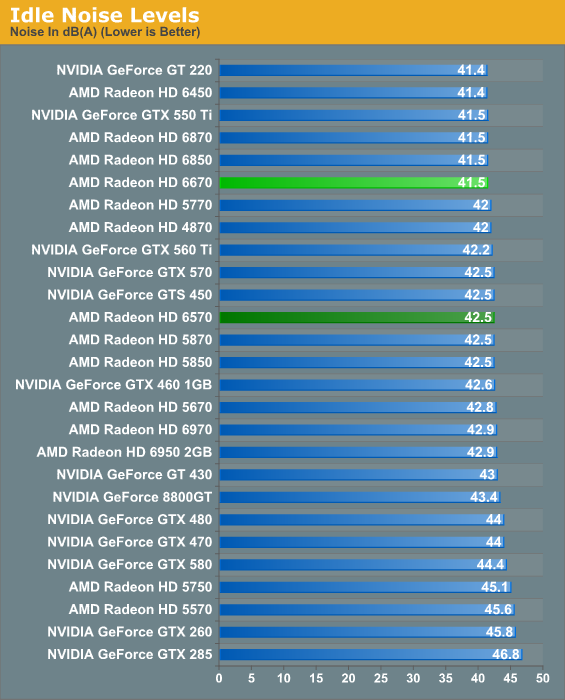
For idle noise, both the 6670 and 6570 are where we’d expect them to be, which is to say almost silent. The 6570 does end up being a bit louder than our noise floor though, which is an interesting outcome given that the 6450 and 5570 are at the noise floor using the same cooler.
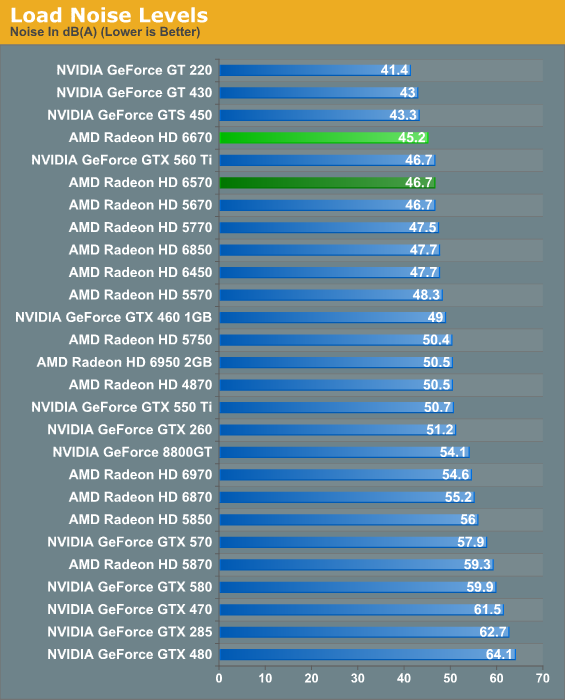
We’re not going to read into our noise results since partner cards will be so different, but if they’re anything like the AMD reference cards then things look pretty good. We’ve had quieter cards, but nothing pushing 60W in a low-profile form factor. If partners go with a full-factor design, then they should be able to meet (or beat) the GTS 450 in noise levels at the cost of some space.
Meanwhile we expect to see passively cooled cards, which should be quite attainable with a full-factor card to hold a larger heatsink.










53 Comments
View All Comments
Ryan Smith - Tuesday, April 19, 2011 - link
Our primary focus on reviews is for the North American market. I'm not sure about Europe and Asia, but in North America the 6450 does (did?) not go on sale in retail until today. It has been available to OEMs for a couple of months however.mino - Tuesday, April 19, 2011 - link
Even ignoring your global audience, if a card was available for MONTHS in the OEM channel, calling it "paper launch" is absurd.But; who pays, he gets. :(
AstroGuardian - Thursday, April 21, 2011 - link
Consider opening an European branch. Many of us do not agree with many things in the reviews.Targon - Tuesday, April 19, 2011 - link
If a game is CPU limited after that many years, that hints that the game is not multi-threaded by design. Both Intel and AMD have really been more focused on multi-core designs, rather than really pushing the performance of individual cores. Yes, there have been improvements, but it has not been the real focus of CPU development. AMD looks to be working on getting the core design improved to be more competitive with Intel, but that is pretty much it at this point. Going to a 32nm CPU design should also help.vavutsikarios - Tuesday, April 19, 2011 - link
I guess it's not really multithreaded, and even if it is, it definitely won't use more than 2 cores. Afterall, it's a 2005 game. But this is besides the point. The game is CPU limited because of its nature. It is not a design flaw or anything. To clarify: the CPU is the limiting factor not from a performance POV but from a gaming experience POV. After you do whatever you have to do you click the "end turn" button. Then you have to wait for the AI to make their move. This takes awhile. It was minutes, worst case, on the PC I had when I first played the game, it may be less than a minute on the 3GHz quadcore I use now. Still, in order to have smooth gameplay, I need this to become 100x faster.SlyNine1 - Wednesday, April 20, 2011 - link
Thats like saying ChessMaster is CPU limited. Or saying Every game out there is HDD/SDD limited. Yes you will have to wait for complexe operations, but it doesn't interfer with gameplay. Because of that its hard pressed to say its CPU limited, as It doesn't limit gameplay.vavutsikarios - Wednesday, April 20, 2011 - link
I understand what you re saying. The CPU speed, at these levels of CPU performance, doesnt interfere with the functions of the game, that is true. But it does affect the gaming experience. Imagine having to wait a couple of hours for the AI. Wouldnt that be really frustrating? More than that, wouldnt it render the game unplayable? The way you define gameplay, having to wait any amount of time doesnt matter. So, I guess, it is a matter of semantics, of definition of what gameplay is.In the broader sense, which, IMHO, is what matters, things like that are important. They directly affect the pleasures we make for ourselves in the precious little time we have. So, yes, obviously, Every Game out there is HDD Limited! -nice line that one :)
Btw: Chessmaster is not CPU limited, although it should be. It is not though, because having to wait for your opponent to move is part of the normal chess experience. Truth is, chessmaster moves way too fast sometimes, and sometimes it thinks a lot when what it has to do is obvious, but still.
AstroGuardian - Thursday, April 21, 2011 - link
+1fic2 - Tuesday, April 19, 2011 - link
CPU limited on an i7-2600k Sandy Bridge? Or CPU limited on the cpu you bought 6 years ago to play Heroes 5?vavutsikarios - Tuesday, April 19, 2011 - link
See my reply to Targon above. An i7-2600 Sandy would probably be a nice improvement over my phenom2, but still a long way from not being the limiting factor.